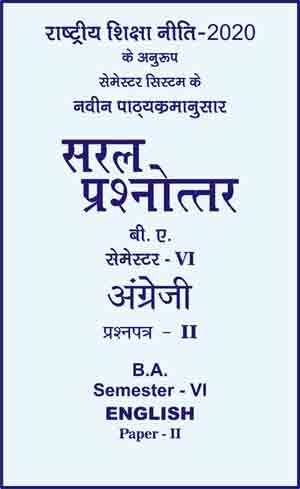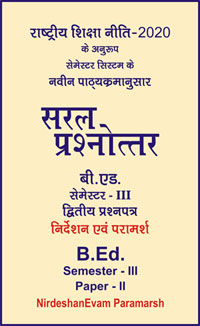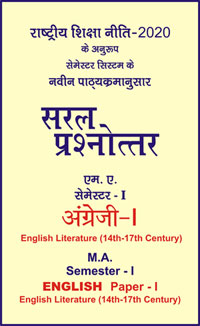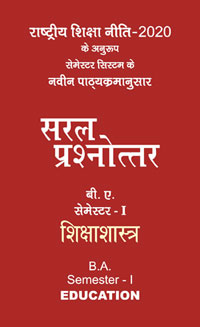|
बी ए - एम ए >> बीए सेमेस्टर 6 अंग्रेजी पेपर 2 बीए सेमेस्टर 6 अंग्रेजी पेपर 2सरल प्रश्नोत्तर समूह
|
|
||||||
बीए सेमेस्टर 6 अंग्रेजी पेपर 2
Chapter 8 - Written English : Precies Paragraph and Essay
Introduction to the Chapter
In written English, there are various forms of writing, each with its specific structure and purpose. Three common forms are précis, paragraph, and essay. Understanding their differences and purposes is crucial for effective writing.
Definition and Purpose
A precis, derived from the French word “précis,” meaning “precise” or “concise,” is a short form of summarization that maintains the tone, mood, and central theme of the original text. In journalism, it is utilized to condense lengthy articles, reports, or speeches into a more digestible and succinct format. The primary objective is to strip the content down to its essentials, presenting the core message in a manner that is both accessible and time-efficient for the reader.
Characteristics of a Good Precis
Brevity : This is the soul of a precis. The idea is not just to shorten the text but to distill it to its essence. Typically, a precis is about one-third the length of the original text.
Clarity : The precis must be lucid and understandable. It should be written in a way that even without the original text, the reader grasps the full idea.
Objectivity : A precis should be free from personal biases or interpretations. It presents the arguments and viewpoints of the original text without the precis writer’s opinions.
Accuracy : The precis must accurately reflect the main ideas, arguments, and conclusions of the original text. No critical information should be distorted or omitted.
Coherence : Despite the condensation, the precis should maintain a logical flow and coherence. The ideas should connect seamlessly, ensuring readability.
Process of Writing a Precis
-
Reading and Understanding : Thoroughly read the original text to grasp its main idea and structure.
-
Note-Taking : Identify and note down the key points and supporting arguments.
-
Writing : Construct a draft that synthesizes the noted ideas into a coherent whole.
- Revising : Edit for clarity, coherence, and conciseness, ensuring adherence to the original text’s intent.
Paragraph
Definition and Purpose
In journalism, a paragraph serves as a building block of an article. It consists of one or more sentences related to a single idea or topic. The purpose of a paragraph in journalistic writing is to organize the information in a clear, concise, and logical manner, aiding in the reader’s understanding.
Characteristics of a Good Paragraph
Unity : All sentences in the paragraph should relate to the central idea.
Coherence : The ideas should flow logically, with clear connections between sentences.
Emphasis : Journalistic paragraphs often follow the inverted pyramid style, placing the most crucial information at the start.
Brevity : Paragraphs in journalistic writing are typically shorter than in academic or literary contexts, making the information more digestible.
Crafting Effective Paragraphs
-
Topic Sentence : Start with a sentence that introduces the main idea.
-
Supporting Sentences : Follow up with sentences that provide details, evidence, or elaboration.
-
Concluding Sentence : Optionally, end with a sentence that summarizes the main idea or transitions to the next paragraph.
Essay
Definition and Purpose
In journalism, an essay is a longer, more detailed piece of writing compared to a news article or report. It presents a balanced argument, personal opinion, or in-depth analysis of a topic. Essays in journalism explore a wide range of subjects, from current events to social issues, often with a narrative that engages and provokes thought in the reader.
Characteristics of a Good Essay
Personal Voice : Unlike standard news reports, essays often reflect the writer’s personal voice and viewpoint.
Argumentation : Essays typically present a clear argument or thesis, supported by evidence and analysis.
Depth and Breadth : They provide a comprehensive exploration of the topic, covering various angles and perspectives.
Engaging and Persuasive : Good essays captivate the reader’s interest and persuade them through logical reasoning and emotional appeal.
Process of Writing an Essay
-
Research and Planning : Understand the topic and plan the structure of the essay.
-
Introduction : Start with a hook and present the thesis statement.
-
Body : Develop the argument with supporting evidence, analysis, and personal insights.
-
Conclusion : Summarize the main points and restate the thesis, providing closure.
-
Revision : Review and refine the essay for clarity, coherence, and impact.
Conclusion
In journalism, precis, paragraphs, and essays serve distinct purposes but are interconnected in their aim to convey information effectively. A precis provides a condensed version of a text, a paragraph offers a focused segment of an idea, and an essay presents a thorough exploration of a subject. Mastery of these forms is essential for any journalist or writer, as they are fundamental to the craft of effective communication.
|
|||||

 i
i 









